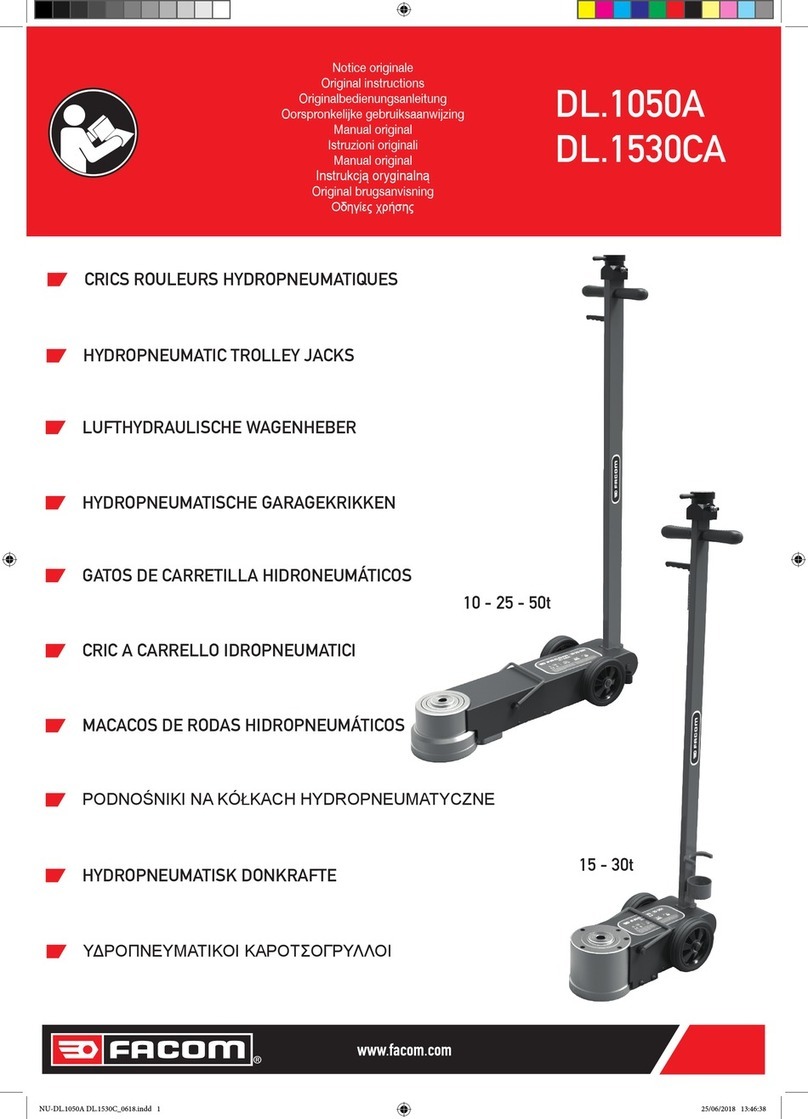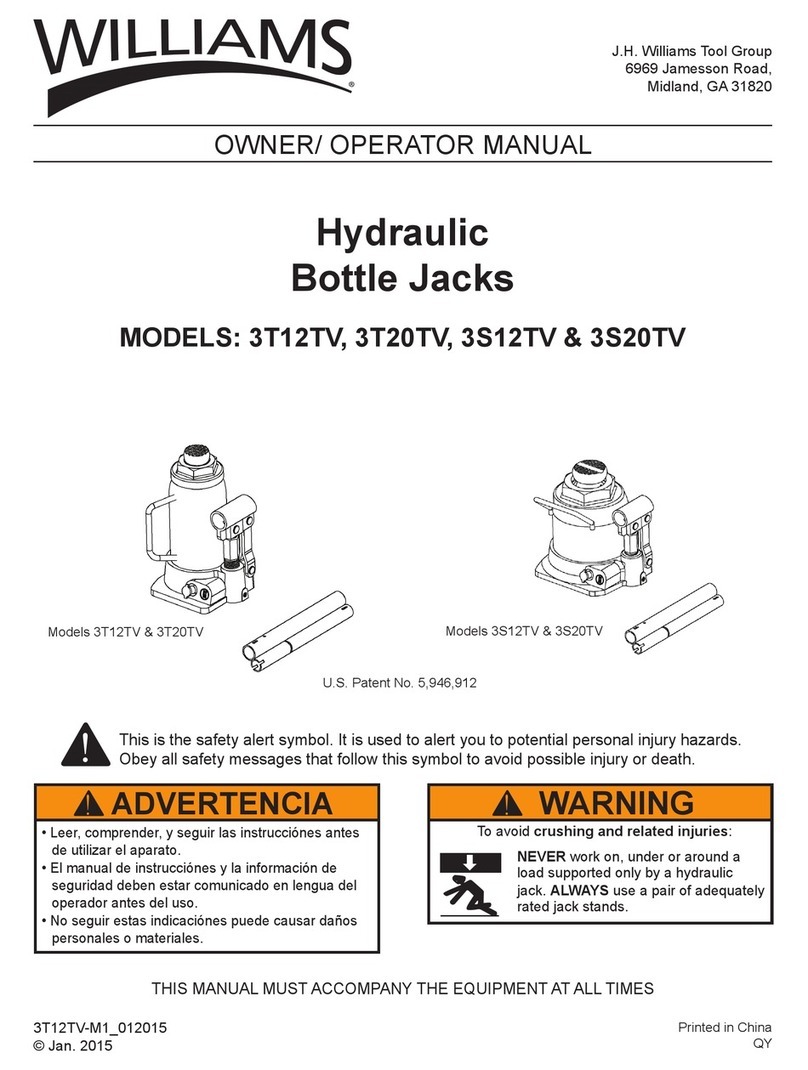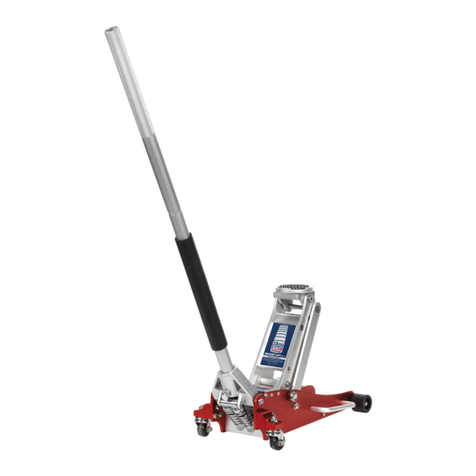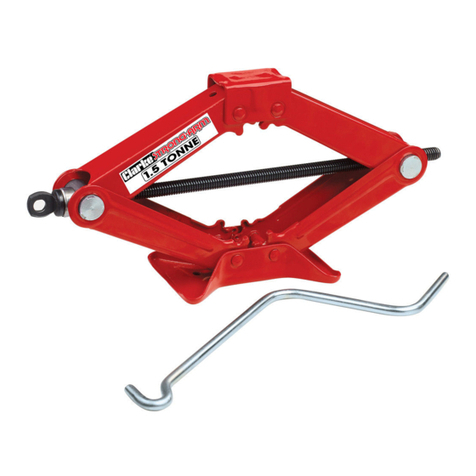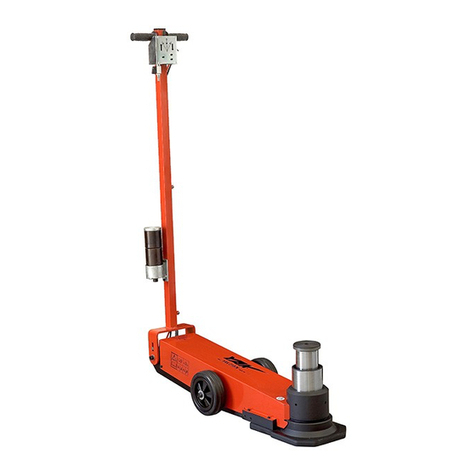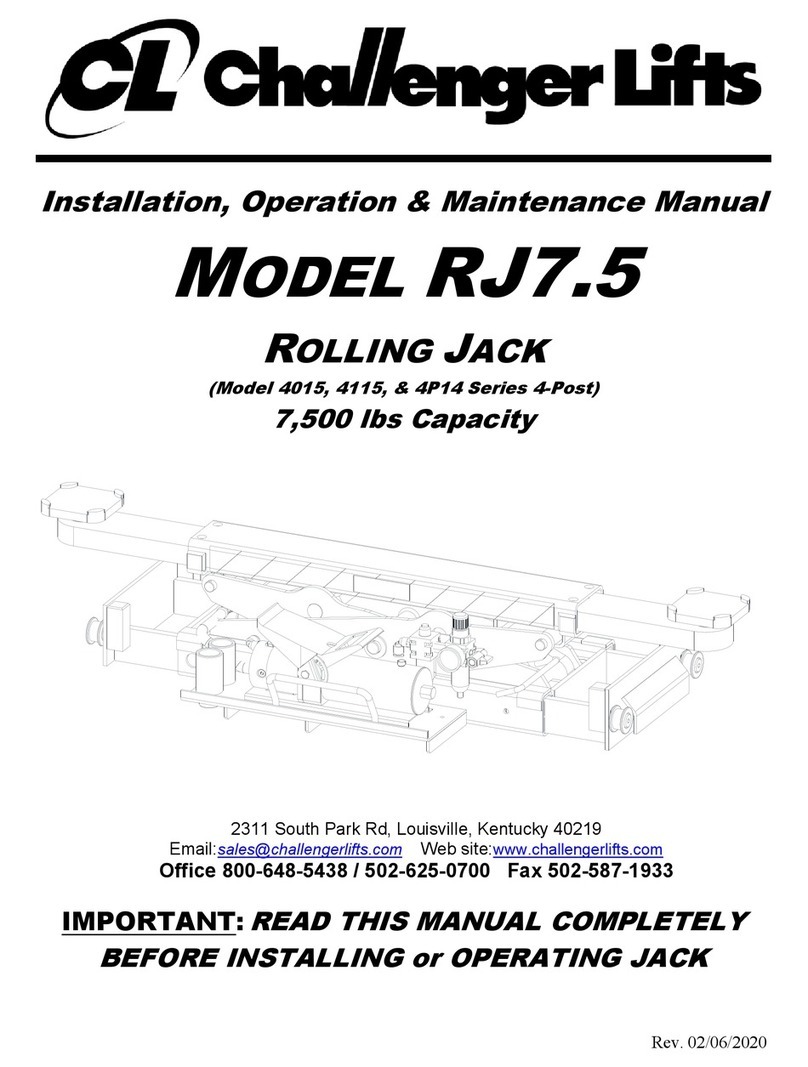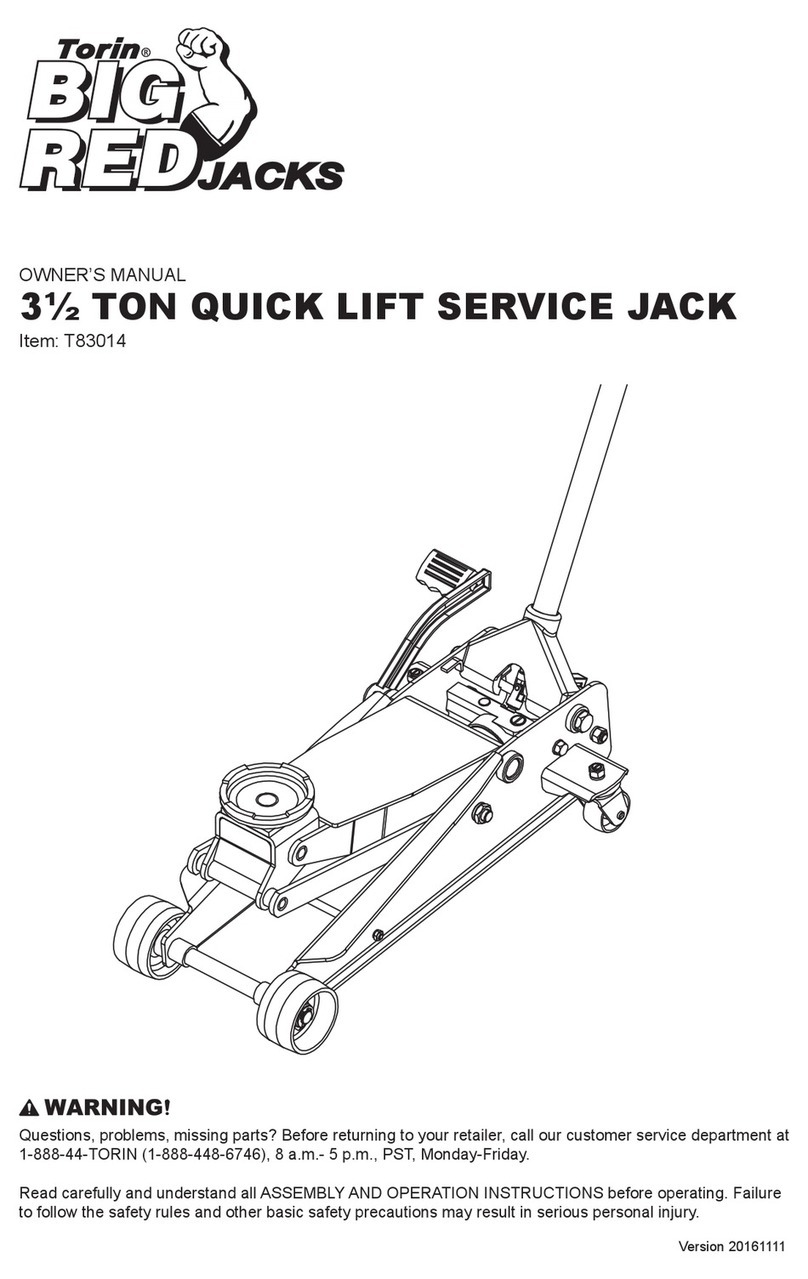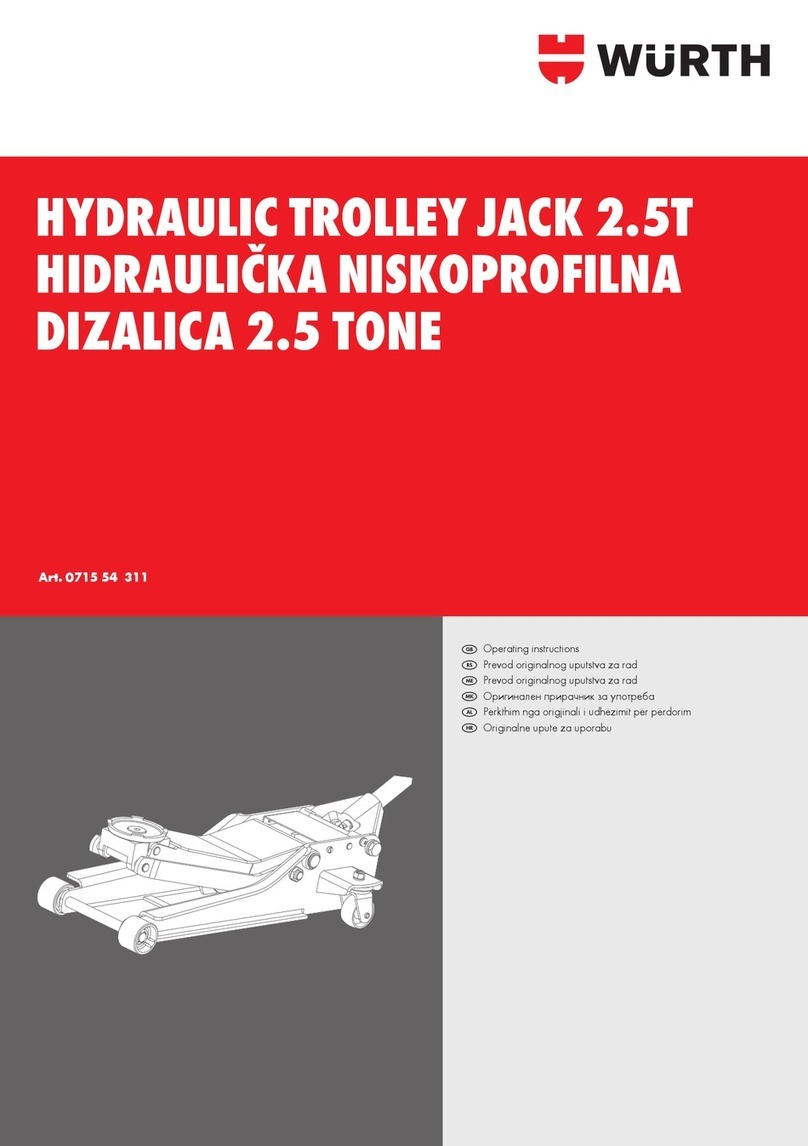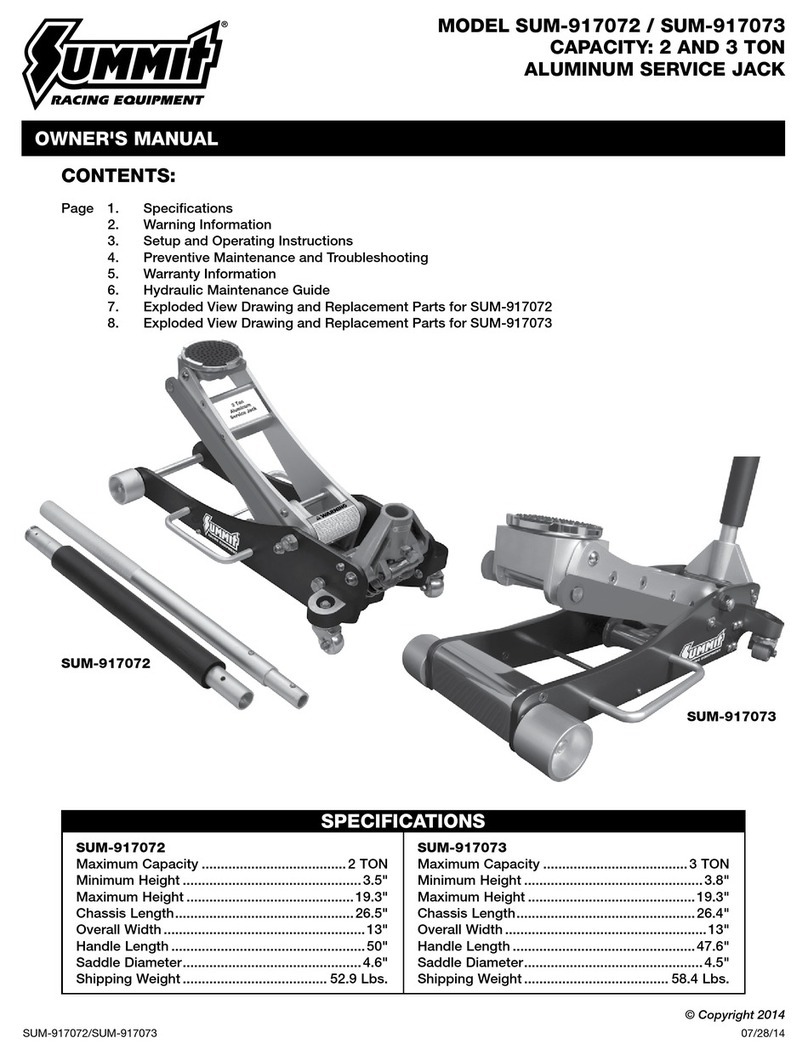Mychanic 52608 User manual

1
Save this manual. For future reference, keep this manual in a safe and dry place
for the safety warnings and precautions, assembly, operating, inspection,
maintenance, and cleaning procedures.
Operating Instruction for Model 52608:
2 Ton Low Prole Hybrid Floor Jack with Dual Pump
INSTRUCTION MANUAL AND PARTS CATALOG
Write the product’s serial number in the back of the manual near the assembly
diagram (or month and year of purchase if the product has no number).

2
Weight capacity: 2 metric tons (4,400 lb) (2,000 kg)
Maximum Height: 18-1/8” (46 cm) (about 5 pumps)
Minimum Height: 3-1/2” (9 cm)
Meets 2009 ANSI/ASME PALD standards and EN 1494:2000+A1:2008
Saddle Size: 3-7/8” (9.8 cm)
To reduce risk of injury, user must read instruction manual. Always use common
sense and pay particular attention to all the DANGER, WARNING, CAUTION, and
NOTE statements in this manual.
Safety symbols in this manual are used to ag possible dangers. The safety symbols and
their explanations require your full understanding. The safety warnings do not, by them-
selves, eliminate any danger, nor are they substitutes for proper accident prevention
measures.
This is the safety alert symbol. It is used to alert you to potential personal injury
hazards. Obey all safety messages that follow this symbol to avoid possible injury
or death.
DANGER indicates a hazardous situation which, if not avoided, will result in death or
serious injury.
WARNING indicates a potentially hazardous situation which, if not avoided, could
result in death or serious injury.
CAUTION indicates a potentially hazardous situation which, if not avoided, may result
in minor or moderate injury.
CAUTION used without the safety alert symbol indicates a potentially hazardous situation
which, if not avoided, may result in property damage.
NOTE provides additional information that is useful for proper use and maintenance of this
tool. If a NOTE is indicated, make sure it is fully understood.
SPECIFICATIONS
EXPLANATION OF SYMBOLS

3
PRODUCT DIAGRAM
Saddle
Saddle Pad
Lifting Arm
Carry
Handle
Rear Caster
Handle Socket
Handle
Grease Service Port
Cover Screw for
Safety Valve;
Do Not Open
or Adjust
U-Joint
Fill Screw
Hydraulic Unit

4
1. Study, understand, and follow all instructions before operating this device.
2. Do not exceed the rated capacity (2 metric tons).
3. Use only on hard, level surfaces.
4. Lifting device ONLY. Immediately after lifting, support the vehicle with
appropriate means.
5. Do not move or dolly the vehicle while on the jack.
6. Failure to heed these markings may result in personal injury and/or
property damage.
7. Lift only areas of the vehicle as specied by the vehicle manufacturer.
8. No alterations shall be made to this product.
9. Never work on, under, or around a load supported only by this device.
10. Do not adjust safety valve.
11. Wear ANSI-approved safety goggles and heavy-duty work gloves during use.
12. Keep clear of load while lifting and lowering.
13. Lower load slowly.
14. Apply parking brake and chock tires before lifting vehicle.
15. Inspect before use; do not use if parts are loose or damaged.
16. Do not use on aircraft.
17. The warnings, precautions, and instructions discussed in this manual cannot
cover all possible conditions and situations that may occur. The operator must
understand that common sense and caution are factors which cannot be built
into this product but must be supplied by the operator.
The brass components of this product contain lead, a chemical known to the
State of California to cause cancer, birth defects, or other reproductive harm.
California Health & Safety code § 25249.5, et seq.
18. Assemble only according to these instructions. Improper assembly can
create hazards.
19. Keep work area clean and well lit. Dark and cluttered work environments invite
hazards.
20. Keep children, pets, and bystanders out of the area during assembly.
Distractions can cause you to lose control of tools, injuring yourself or others.
21. Stay alert, watch what you are doing, and use common sense when operating
a power tool. Do not assemble while you are tired or under the inuence of
alcohol, drugs, or medication. A moment of inattention while operating tools
may result in serious personal injury.
22. Weight capacity and other product capabilities apply to properly and
completely assembled product only. Do not use if incompletely or
improperly assembled.
IMPORTANT SAFETY INFORMATION

5
23. This product is not a toy. Do not allow children to play with or near this item,
and store out of reach of children.
24. Maintain product labels and nameplates. These carry important safety
information.
Read the ENTIRE IMPORTANT SAFETY INFORMATION section at the beginning
of this manual before set up or use of this product.
Note: For additional information regarding the parts listed in the following pages,
refer to the Parts List and Assembly Diagram section.
IMPORTANT! Before first use:
Check hydraulic oil level and ll to 1/4” (6 mm) below the ll port as needed as
stated below. Thoroughly test the jack for proper operation. If it does not work
properly, bleed air from its hydraulic system as stated below.
TOOL SET UP
Attaching the Handle
1. Attached the upper handle to the lower handle.
2. Loosen the set screw and insert the assembled handle into the handle
socket.
3. Tighten the set screw.
BLEEDING
Before each use or if jack performance decreases,check for excessive air and
proper hydraulic uid level in jack. If jack appears to not be working properly, it
may be necessary to purge its hydraulic system of excessive air as follows:
1. Loosen the ll screw.
2. Twist the handle counterclockwise to open the valve.
3. Check uid level and, if necessary, top off according to Adding Hydraulic
Fluid below.
4. Twist the handle clockwise to close the valve, then pump the handle
quickly several times.
5. Replace ll screw.
SETUP PRIOR TO USE
USE INSTRUCTIONS

6
IMPORTANT: After bleeding the jack, test the jack for proper
operation prior to its actual use.
6. If, after bleeding, the jack does not appear to be working properly, do not use
it until repaired by a qualied service technician.
ADDING HYDRAULIC FLUID
1. Remove the ll screw. Do not remove or loosen safety valve cover screws.
2. Add high grade hydraulic uid (#32 hydraulic oil—sold separately) slowly until
the uid reaches 1/4” (6 mm) below the top of the ll port.
Note: Do not touch the handle when adding hydraulic uid.
3. Replace ll screw.
LIFTING
WARNING Park vehicle on a flat, level, solid surface safely away from oncoming
traffic. Turn off the vehicle’s engine. Place the vehicle’s transmission in “park” (if
automatic) or in its lowest gear (if manual). Set the vehicle’s emergency brake.
Then chock the wheels that are not being lifted.
1. Slowly twist the handle counterclockwise to lower the jack. Once the jack is
fully lowered, twist the handle rmly clockwise.
2. Carefully position the jack’s saddle under the vehicle manufacturer’s
recommended lifting point (see vehicle manufacturer’s owner’s manual for
location of frame lifting point).
3. Pump the handle until the top of the saddle has nearly reached the vehicle’s
lifting point. Position the saddle directly under the vehicle’s lifting point.
4. To lift the vehicle, pump the handle. Use only smooth, full strokes.
5. Select matching jack stands (sold separately) of appropriate capacity. Set the
jack stands to the same height according to the manufacturer’s instructions,
making sure they lock securely into position.
6. Position the jack stands’ saddles under the vehicle manufacturer’s
recommended support points.
WARNING Ensure that the vehicle support points are fully seated in the
saddles of both jack stands. Use a matched pair of jack stands per vehicle to
support one end only.
7. Slowly twist the handle counterclockwise to lower the vehicle onto the jack
stands’ saddles.
8. Once the vehicle is fully seated on the jack stands, continue slowly lowering
the jack until it is completely lowered.

7
9. Remove the jack and store safely out of the way.
CAUTION: This jack is equipped with a safety valve to prevent overload. If the
vehicle’s or load’s total weight is beyond the rated capacity of 2 metric tons, the
jack will not work. If the jack begins to eject hydraulic uid from the overload valve,
the jack is overloaded. Do not attempt to continue to lift the load. Please release
the load slowly to the ground and do not attempt to lift again.
Be sure to check the uid level before using to lift any lighter loads.
LOWERING
1. Carefully remove all tools, parts, etc. from under the vehicle.
2. Position the jack’s saddle under the lifting point. Turn the handle rmly clock-
wise and raise vehicle high enough to clear the jack stands.
3. Carefully remove the jack stands.
4. Slowly turn the handle counterclockwise to lower the vehicle to the ground.
5. Lower the jack completely. Store the jack indoors out of the reach of children.
CAUTION: Ensure all body parts are free of moving parts of oor jack
Procedures not specically explained in this manual must be performed only by a
qualied technician.
TO PREVENT SERIOUS INJURY FROM TOOL FAILURE: Do not use damaged
equipment. If abnormal noise or vibration occurs, have the problem corrected
before further use.
CLEANING, MAINTENANCE, AND LUBRICATION
1. BEFORE EACH USE, inspect the general condition of the jack. Check for:
• Loose hardware
• Misalignment or binding of moving parts
• Cracked or broken parts
• Any condition that may affect its safe operation
2. BEFORE EACH USE, thoroughly test the jack for proper operation prior to its
actual use. If the jack appears to not be working properly, follow bleeding
instructions above.
3. AT LEAST ONCE EVERY THREE YEARS, change the hydraulic uid:
• With the jack fully lowered, remove the ll screw.
• Tip the jack over to allow the old hydraulic uid to drain out completely.
Dispose of the old hydraulic uid in accordance with local regulations.
• With the jack upright, completely ll the hydraulic unit with high
MAINTENANCE AND SERVICE

8
grade hydraulic uid until the uid is 1/4” (6 mm) below the top
of the ll port.
• Turn the handle counterclockwise to pin the release valve.
• Pump the handle up and down quickly several times to purge air
from the system.
• Recheck uid level and re-ll as needed.
• Replace the ll screw.
4. AFTER EACH USE, WIPE WITH A CLEAN CLOTH. Store the jack indoors
out of the reach of children.
5. For best results and tting, occasionally check the lifting arm bearing for
lubrication. The lift arm has a grease tting, and grease can be applied using a
grease gun. NLGI Grade 2 lithium-based grease is recommended.
WARNING
TO PREVENT SERIOUS INJURY:
Use caution when troubleshooting a malfunctioning jack. Stay well clear
of the supported load. Completely resolve all problems before use. If the
solutions presented in the troubleshooting guide do not solve the problem,
have a qualified technician inspect and repair the jack before use.
After the jack is repaired, test it carefully without a load by raising and
lowering it fully. Check for proper operation BEFORE RETURNING THE
JACK TO OPERATION.
DO NOT USE A DAMAGED OR MALFUNCTIONING JACK!
TROUBLESHOOTING

9
Jack will
not lift at
its weight
capacity
Saddle
lowers
under
load
Pump
stroke
feels
spongy
Saddle
will not
lift all
the way
Handle
moves up
when jack
is under
load
Fluid
leaking
from ll
plug
Make certain that the jack is
not supporting a load while
attempting a solution
X X
Check that release valve is fully
closed.
Jack may require bleeding - see
instructions above.
X X X
Valves may be blocked and
may not close fully. To ush
the valves:
1. Lower the saddle and
securely close the release valve.
2. Manually lift the saddle
several inches.
3. Open the release valve by
turning the handle counter-
clockwise and forcing the
saddle down as quickly as
possible.
X X
Jack may be low on hydraulic
uid. Check uid level and rell
if needed –- see instructions
above.
Jack may require bleeding --
see instructions above.
X
Unit may have too much hy-
draulic uid inside. Check uid
level and adjust if needed – see
instructions above.
Possible Symptoms Probable Solution
PLEASE READ THE FOLLOWING CAREFULLY
THE MANUFACTURER AND/OR DISTRIBUTOR HAS PROVIDED THE PARTS LIST AND
ASSEMBLY DIAGRAM IN THIS MANUAL AS A REFERENCE TOOL ONLY. NEITHER THE
MANUFACTURER NOR DISTRIBUTOR MAKES ANY REPRESENTATION OR WARRANTY
OF ANY KIND TO THE BUYER THAT HE OR SHE IS QUALIFIED TO MAKE ANY
REPAIRS TO THE PRODUCT, OR THAT HE OR SHE IS QUALIFIED TO REPLACE ANY

10
PARTS OF THE PRODUCT. IN FACT, THE MANUFACTURER AND/OR DISTRIBUTOR
EXPRESSLY STATES THAT ALL REPAIRS AND PARTS REPLACEMENTS SHOULD BE
UNDERTAKEN BY CERTIFIED AND LICENSED TECHNICIANS, AND NOT BY THE BUYER.
THE BUYER ASSUMES ALL RISK AND LIABILITY ARISING OUT OF HIS OR HER REPAIRS
TO THE ORIGINAL PRODUCT OR REPLACEMENT PARTS THERETO, OR ARISING OUT
OF HIS OR HER INSTALLATION OF REPLACEMENT PARTS THERETO.
Record Product’s Serial Number Here:__________________________________
Note: If product has no serial number, record month and year of purchase instead.
Note: Some parts are listed and shown for illustration purposes only, and are not available
individually or as replacement parts.
Parts List and Diagram

11
NO. DESCRIPTION Q'TY NO. DESCRIPTION Q'TY
3Sleeve 127 Shaft Ring Ф 20 2
4Retaining Ring 128 Oil Cup 1
5Base Of Handle 129 Lifting Structure 1
6Pin 130 Lifting Shaft 1
7Pump Core Wheel 131 Nut 2
8Shaft Rin Ф12 132 Washer 6
9Limiting Screw 133 Adjustable Plate 2
10 Pump 134 Nut 2
11 Install Shaft 235 Head Screw 6
12 Big Washer 436 Spring Washer 6
13 Spring Washer 837 Bolt 2
14 Head Cap Screw 838 Bushing 2
15 Bolt 239 Fixed Wheel 2
16 Spring Washer 240 Welded Base 2
17 Base Of Wheel 241 Shaft Ring Ф 16 2
18 Caster 242 Bearing Of Front Wheel 1
19 Screw M12*35 243 Washer 6
20 Screw M12*25 444 Carrying Handle 1
21 Limited Rod 345 Saddle 1
22 Screw M8*16 446 Screw 1
23 Spring 247 Rubber Saddle 1
24 Pin 148 Spring Washer 6
25 Bolt 249 Tool Tray 1
26 Rod Assy 150 Hex Socket, Truss Head
Screw
4

12
IMPORTED BY
DELK
Nashville, TN 37209
www.mychanic.us
© 2016. DELK, MYCHANIC, TURN YOUR OWN WRENCH, and the MYCHANIC logo are
registered trademarks of DELK.

13
Guarde este manual. Conserve este manual para consulta futura en un lugar
seguro y seco, para las advertencias y precauciones de seguridad, procesos de
ensamblaje, operación, inspección, mantenimiento y limpieza.
Instrucciones operativas para el Modelo 52608:
Gato Híbrido de Bajo Per de 2 Toneladas con Bomba Doble
MANUAL DE INSTRUCCIONES Y CATÁLOGO DE PIEZAS
Escriba el número de serie del producto en el dorso del manual, cerca del
diagrama de ensamblaje (o el mes y el año de compra, si el producto no posee
ningún número).

14
Capacidad de peso: Toneladas métricas (4,400 lb) (2,000 kg)
Altura máxima: 18-1/8” (46 cm) (alrededor de 5 bombas)
Altura mínima: 3-1/2” (9 cm)
Cumple con las normas 2009 ANSI/ASME PALD y EN 1494:2000+A1:2008
Tamaño del asiento: 3-7/8” (9.8 cm)
Para reducir el riesgo de lesiones, el usuario debe leer el manual de instrucciones.
Siempre utilice el sentido común y preste especial atención a todas las indica-
ciones de PELIGRO, ADVERTENCIA, PRECAUCIÓN y NOTAS en este manual.
Los símbolos de seguridad de este manual se utilizan para señalar posibles peligros. Los
símbolos de seguridad y sus explicaciones requieren comprensión total por parte del pro-
pietario. Las advertencias de seguridad de por sí no eliminan cualquier peligro, ni sustituy-
en las medidas adecuadas de prevención de accidentes.
Ese es el símbolo de alerta de seguridad. Se utiliza para alertarle sobre posibles
peligros de lesiones personales. Obedezca todos los mensajes de seguridad que siguen
este símbolo para evitar una posible lesión o la muerte.
PELIGRO indica una situación de peligro la cual, si no se evita, dará como resultado la
muerte o una lesión grave.
ADVERTENCIA indica una posible situación de peligro la cual, si no se evita, podría dar
como resultado la muerte o una lesión grave.
PRECAUCIÓN indica una posible situación de peligro la cual, si no se evita, podría dar
como resultado una lesión menor o moderada.
PRECAUCIÓN: utilizada sin el símbolo de alerta de seguridad, indica una posible situación
peligrosa la cual, si no se evita, puede dar como resultado daños a la propiedad.
NOTA: proporciona información adicional que es útil para el uso y mantenimiento adecua-
dos de esta herramienta. Si se indica una NOTA, asegúrese de que se
comprenda completamente.
ESPECIFICACIONES
EXPLICACIÓN DE LOS SÍMBOLOS

15
DIAGRAMA DEL PRODUCTO
Asiento
Cojinete del asiento
Brazo para
elevación
Mango de
transporte
Rueda
Cavidad para el
mango
Mango
Puerto de servicio
de grasa
Tornillo de cubi-
erta para válvula
de seguridad. No
abrir ni ajustar.
Junta en U
Tornillo de llenado
Unidad hidráulica

16
1. Estudie, comprenda y siga todas las instrucciones antes de operar este dispositivo.
2. No exceder la capacidad indicada (toneladas métricas).
3. Usar solo en supercies duras y niveladas.
4. Dispositivo para elevación SOLAMENTE. Inmediatamente luego de la elevación,
sostenga el vehículo con los medios adecuados.
5. No mueva ni traslade el vehículo en una plataforma móvil mientras el gato esté
colocado.
6. No cumplir estas indicaciones puede provocar lesiones personales y/o daños a la
propiedad.
7. Eleve áreas del vehículo únicamente según las especicaciones del fabricante
del vehículo.
8. No se debe realizar ninguna alteración en este producto.
9. Nunca trabaje sobre, debajo ni alrededor de una carga que solo esté sostenida
por este dispositivo.
10. No ajuste la válvula de seguridad.
11. Durante el uso, utilice anteojos de seguridad aprobados según la Norma ANSI y
guantes para trabajo pesado.
12. Mantenga sin carga durante la elevación y el descenso.
13. Descienda la carga lentamente.
14. Aplique el freno de estacionamiento y cuña para neumáticos antes de elevar
el vehículo.
15. Inspecciónelo antes de su uso; no lo utilice si tiene piezas sueltas o dañadas.
16. No lo use en aviones.
17. Las advertencias, precauciones e instrucciones que se analizan en este manual no
pueden cubrir todas las condiciones y situaciones posibles que puedan suceder. El
operador debe comprender que el sentido común y la precaución son factores que no
se pueden incorporar en este producto, pero que debe suministrar el operador.
Los componentes metálicos de este producto contienen plomo, una sustancia química
que en el estado de California se sabe que causa cáncer, malformaciones congénitas u
otros daños reproductivos. Código de California Health & Safety § 25249.5, et seq.
18. Ensamblar únicamente según estas instrucciones. El ensamblaje incorrecto puede
ocasionar riesgos.
19. Mantenga el área de trabajo limpia y bien iluminada. Los lugares de trabajo oscuros y
desordenados son una fuente de riesgos.
20. Mantenga a los niños, mascotas y espectadores fuera de la zona durante el
ensamblaje. Las distracciones pueden hacer que pierda el control de las herramientas
y se lesione usted mismo o a otras personas.
21. Manténgase alerta, observe lo que hace y utilice el sentido común al operar una
herramienta eléctrica. No haga el ensamblaje cuando esté cansado o bajo la inuencia
del alcohol, drogas o medicamentos. Un momento de falta de atención al operar
herramientas puede dar como resultado una lesión personal grave.
INFORMACIÓN IMPORTANTE DE SEGURIDAD

17
22. La capacidad de peso y otras capacidades del producto únicamente se aplican
al producto correcta y completamente ensamblado. No utilizar si está ensam
blado de manera incorrecta o incompleta.
23. Este producto no es un juguete. No permita que los niños jueguen con este
producto o cerca de él, y guárdelo fuera del alcance de los niños.
24. Dé mantenimiento a las etiquetas y a placas de identicación del producto.
Estas contienen información importante de seguridad.
Antes de ensamblar o usar este producto lea TODA la sección de INFOR-
MACIÓN IMPORTANTE DE SEGURIDAD al principio de este manual.
Nota: Para información adicional sobre las piezas enumeradas en las páginas sigui-
entes, consulte la sección Lista de piezas y Diagrama de ensamblaje.
¡IMPORTANTE! Antes del primer uso:
Verique el nivel del aceite hidráulico y llene hasta ¼1/4” (6 mm) por debajo del
puerto de llenado según se necesite y tal como se indica más abajo. Pruebe
minuciosamente el funcionamiento adecuado del gato. Si no funciona adecuada-
mente, elimine el aire de su sistema hidráulico tal como se indica más abajo.
ENSAMBLE DE LA HERRAMIENTA
Colocación del mango
1. Coloque el mango superior en el mango inferior.
2. Aoje el tornillo de presión e inserte el mango ensamblado en la cavidad
para el mango.
3. Ajuste el tornillo de presión.
ELIMINACIÓN DE AIRE
Antes de cada uso o si el rendimiento del gato disminuye, verique que no haya
aire excesivo y que el nivel del líquido hidráulico sea adecuado en el gato. Si el
gato parece no funcionar adecuadamente, posiblemente sea necesario purgar su
sistema hidráulico para eliminar el aire excesivo de la siguiente manera:
1. Aoje el tornillo de llenado.
2. Gire el mango en sentido antihorario para abrir la válvula.
3. Verique el nivel del líquido y, si es necesario, complételo según las
indicaciones para Agregar líquido hidráulico a continuación.
CONFIGURACIÓN ANTES DEL USO
INSTRUCCIONES DE USO

18
4. Gire el mango en sentido horario para cerrar la válvula, luego bombee el man
go rápidamente varias veces.
5. Coloque nuevamente el tornillo de llenado.
IMPORTANTE: Después de eliminar el aire excesivo del gato, verifique que el
gato funcione adecuadamente antes de su uso.
6. Si, después de eliminar el aire excesivo, el gato parece no funcionar
adecuadamente, no lo use hasta que sea reparado por un técnico de
servicio calicado.
AGREGAR LÍQUIDO HIDRÁULICO
1. Retire el tornillo de llenado. No retire ni aoje los tornillos de cubierta de la
válvula de seguridad.
2. Agregue líquido hidráulico de alto grado (aceite hidráulico n.° 32) (se vende
por separado) lentamente hasta que el líquido alcance 1/4” (6 mm) por debajo
de la parte superior del puerto de llenado.
Nota: No toque el mango cuando agrega líquido hidráulico.
3. Coloque nuevamente el tornillo de llenado.
ELEVACIÓN
ADVERTENCIA Estacione el vehículo en una superficie plana, nivelada y sólida,
segura y alejada del tráfico que se aproxima. Apague el motor del vehículo.
Coloque la transmisión del vehículo en “estacionamiento” (si es automático) o en su
marcha más baja (si es manual). Coloque el freno de emergencia del vehículo.
Luego, coloque una cuña en las ruedas que no se levantarán.
1. Gire lentamente el mango en sentido antihorario para bajar el gato. Una vez
que el gato está totalmente descendido, gire el mango rmemente en sentido
horario.
2. Coloque cuidadosamente el asiento del gato debajo del punto de elevación
recomendado del fabricante del vehículo. (Consulte el manual del usuario del
fabricante para conocer el lugar del punto de elevación).
3. Bombee el mango hasta que la parte superior del asiento esté muy cerca del
punto de elevación del vehículo. Coloque el asiento directamente debajo del
punto de elevación del vehículo.
4. Para elevar el vehículo, bombee el mango. Realice solamente movimientos
suaves y completos.
5. Seleccione las plataformas correspondientes del gato (se venden por separa
do) de la capacidad adecuada. Coloque las plataformas del gato a

19
la misma altura según las instrucciones del fabricante, asegurándose de
que se traban de manera segura en su posición.
6. Coloque los asientos de las plataformas del gato debajo de los puntos de
elevación recomendados del fabricante del vehículo.
ADVERTENCIA Asegúrese de que los puntos de soporte del vehículo
estén completamente asentados en los asientos de ambas plataformas del
gato. Use el par correspondiente de plataformas del gato por vehículo para
brindar soporte a un extremo solamente.
7. Gire lentamente el mango en sentido antihorario para descender el
vehículo a los asientos de las plataformas del gato.
8. Una vez que el vehículo esté completamente asentado en los asientos del
gato, continúe bajando lentamente el gato hasta que lo haya bajado
completamente.
9. Retire el gato y guárdelo en forma segura.
PRECAUCIÓN: Este gato está equipado con una válvula de seguridad para
impedir la sobrecarga. Si el peso total del vehículo o la carga supera la
capacidad indicada de 2 toneladas, el gato no funcionará. Si el gato comienza
a eyectar líquido hidráulico por la válvula de sobrecarga, el gato está so-
brecargado. No intente continuar elevando la carga. Deje la carga lentamente
en el suelo y no intente levantarla nuevamente.
Asegúrese de vericar el nivel del líquido antes de utilizarlo para levantar cual-
quier carga más liviana.
DESCENSO
1. Quite lentamente todas las herramientas, piezas, etc., de abajo del
vehículo.
2. Coloque el asiento del gato debajo del punto de elevación. Gire el man
go en forma rme en sentido horario y eleve el vehículo lo
sucientemente alto para liberar las plataformas del gato.
3. Retire lentamente las plataformas del gato.
4. Gire lentamente el mango en sentido antihorario para descender el
vehículo hasta el suelo.
5. Baje el gato completamente. Guarde el gato fuera del alcance de
los niños.
PRECAUCIÓN: Asegúrese de que todas las partes del cuerpo estén libres
de las piezas móviles del gato en el suelo

20
Los procedimientos no explicados especícamente en este manual deben ser realiza-
dos solo por un técnico cualicado.
PARA PREVENIR LESIONES LIBRES POR LA FALLA DE LA HERRAMIENTA: no utilice
equipos dañados. Si se presentan ruidos anormales o vibración, haga que corrijan el
problema antes de volver a utilizarla.
LIMPIEZA, MANTENIMIENTO Y LUBRICACIÓN
1. ANTES DE CADA USO, inspeccione el estado general del gato.
Revise lo siguiente:
• que no haya piezas metálicas oja;
• que no haya desalineación o unión de piezas móviles;
• que no haya partes agrietadas o rotas;
• que no haya cualquier condición que pueda afectar su funcionamiento
seguro.
2. ANTES DE CADA USO, pruebe cuidadosamente el gato para ver que funcione
adecuadamente antes de su uso. Si el gato parece no estar funcionando
adecuadamente, siga las instrucciones de más arriba para eliminación de aire.
3. AL MENOS UNA VEZ CADA TRES AÑOS, cambie el líquido hidráulico:
• Con el gato totalmente descendido, retire el tornillo de llenado.
• Aplique golpes suaves en el gato para permitir que el líquido hidráulico viejo
salga completamente. Deseche el líquido hidráulico viejo de conformidad
con las reglamentaciones locales.
• Con el gato en posición vertical, llene completamente la unidad hidráulica
con líquido hidráulico de alto grado hasta que el líquido esté ¼” (6 mm) por
debajo de la parte superior del puerto de llenado.
• Gire el mango en sentido antihorario para limitar la válvula de reducción
de presión.
• Bombee el mango hacia arriba y hacia abajo rápidamente varias veces para
purgar el aire del sistema.
• Verique nuevamente el nivel del líquido y rellene según sea necesario.
• Coloque nuevamente el tornillo de llenado.
4. DESPUÉS DE CADA USO, LIMPIE CON UN TRAPO LIMPIO. Guarde el gato
fuera del alcance de los niños.
5. Para obtener los mejores resultados y funcionamiento, verique ocasionalmente
la lubricación del brazo de elevación. El brazo de elevación tiene un accesorio
para grasa, y se puede aplicar grasa mediante un inyector de grasa. Se
recomienda usar grasa con litio grado NLGI 2.
MANTENIMIENTO Y SERVICIO
Table of contents
Languages:
Popular Jack manuals by other brands

Westfalia
Westfalia 116194 instruction manual
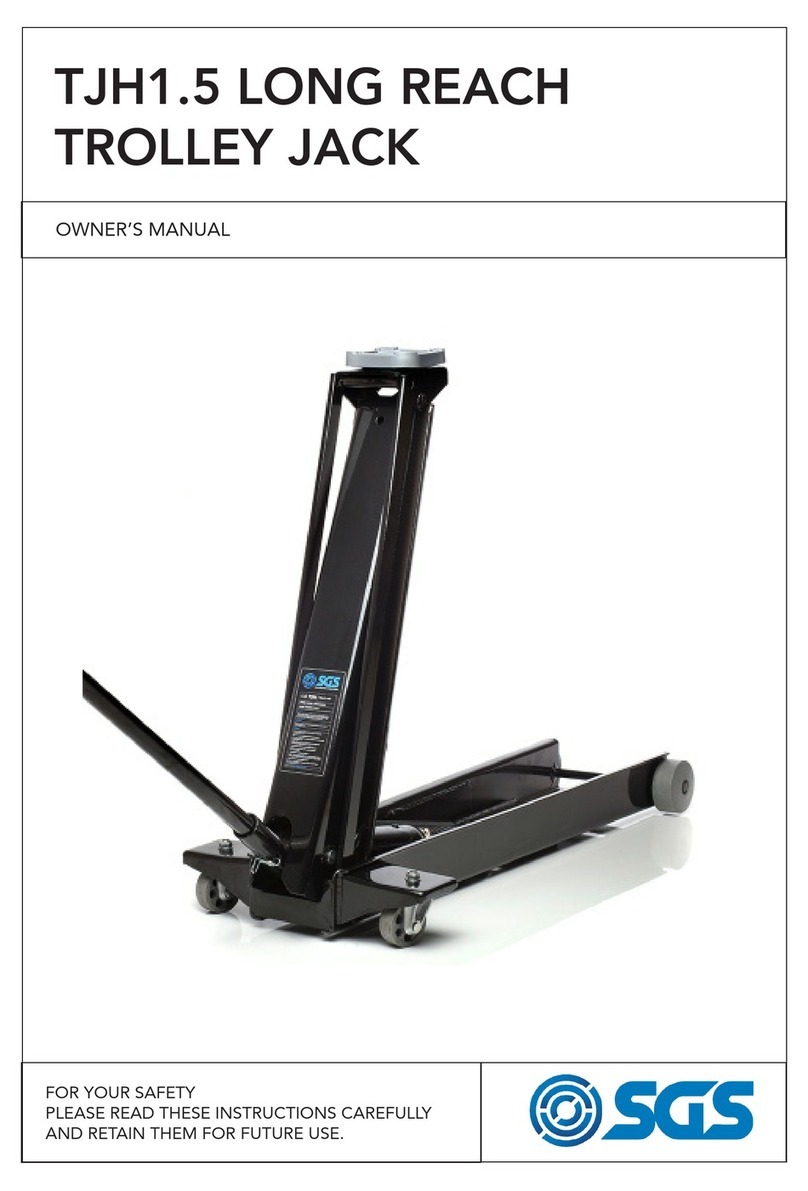
SGS
SGS TJH1.5 owner's manual
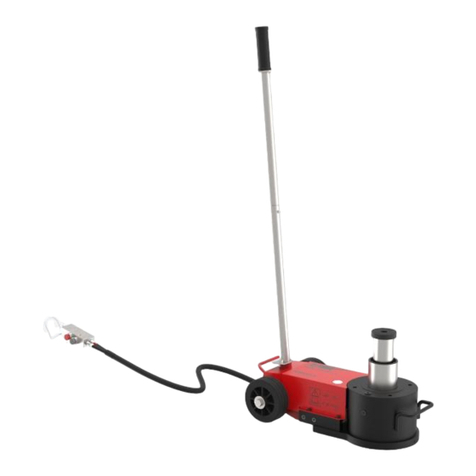
Cattini Oleopneumatica
Cattini Oleopneumatica YAK 215/P Operating and maintenance manual
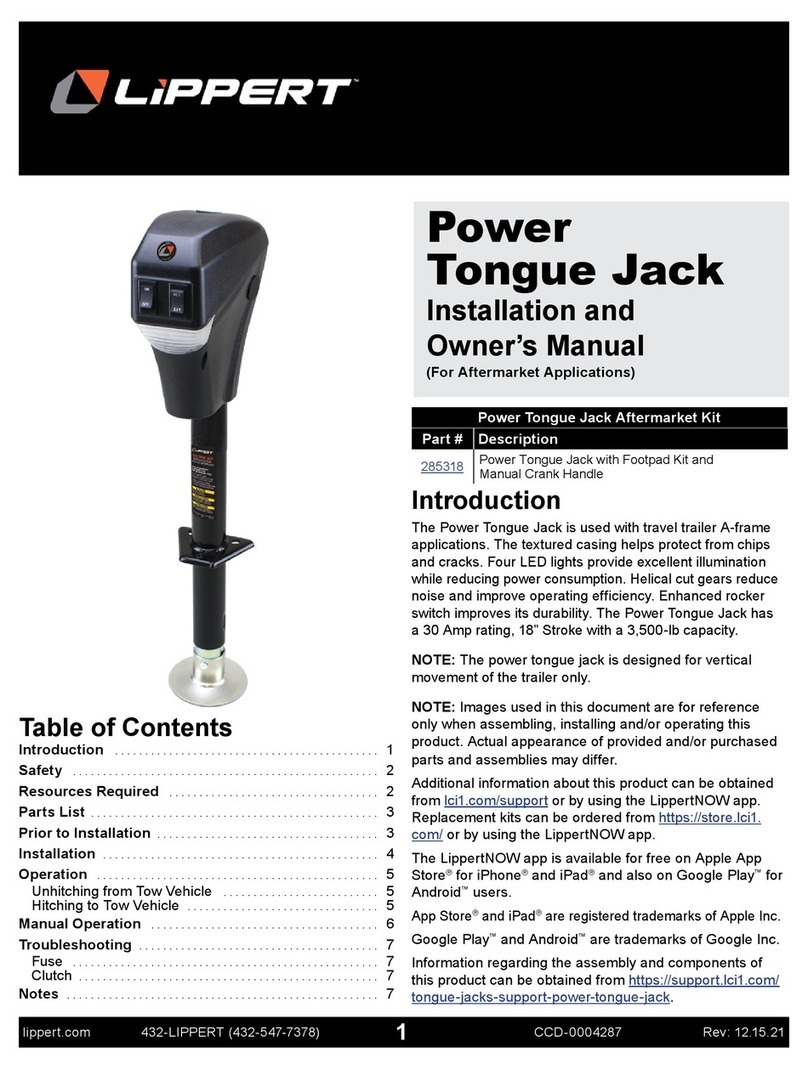
Lippert
Lippert 285318 Installation and owner's manual
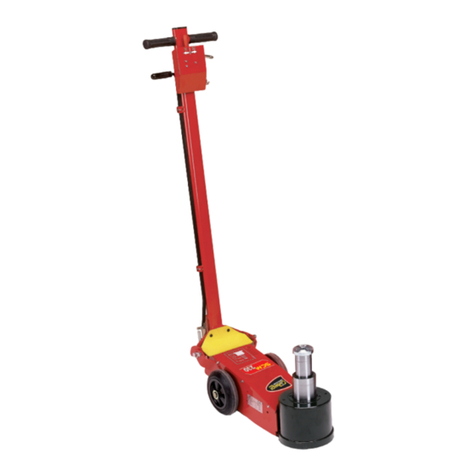
Cormach
Cormach SCM 230 Use and maintenance manual
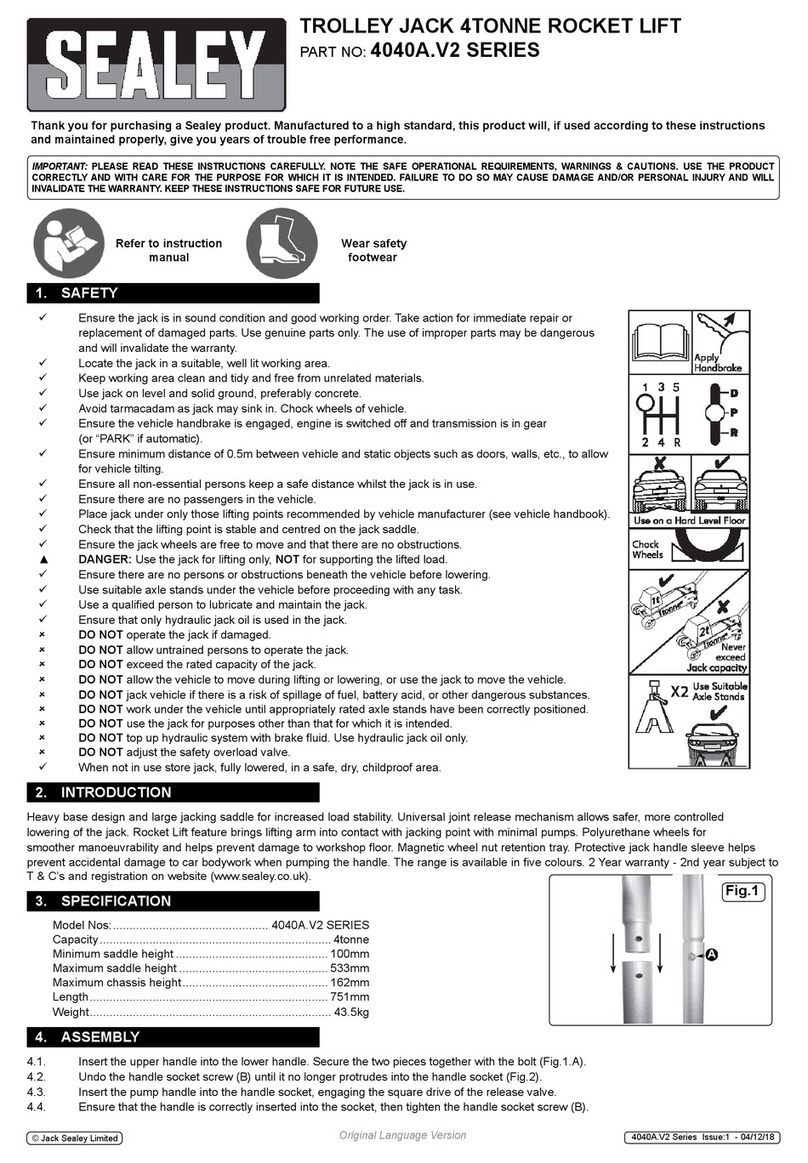
Sealey
Sealey 4040A.V2 Series quick start guide
